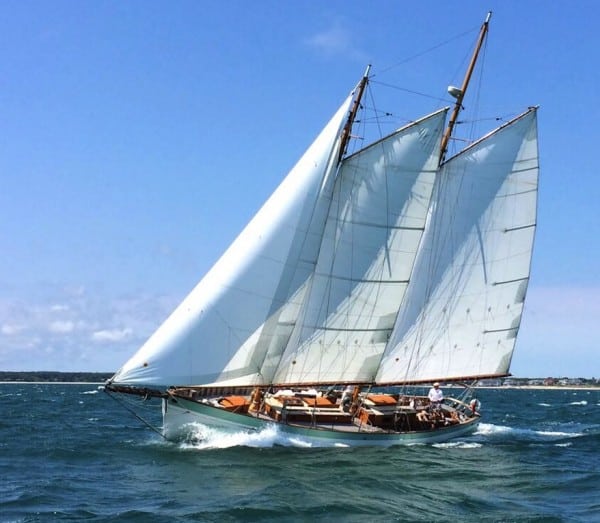This is about sailing and giving, both of which OCH Guide, Nat Benjamin, excels at. In CHARLOTTE, a wooden schooner that Nat designed and built for himself and his family, Nat takes us on a winter voyage to the south coast of Haiti where he delivers a boatload of supplies to a local orphanage, and learns about the people who live there. Nat’s booklet, Passage to Haiti, which had limited circulation, compelled us to create a Guide Post so that OCH members could read about CHARLOTTE’s voyage.
Part 1 of this two-part series gets us, by water and in winter, from New England to Haiti via Bermuda. Part 2 will cover what a Haitian coastal village is like.

At 1000 hrs on December 10, 2014, 13 days after our snowy departure from Martha’s Vineyard, MA, we sighted the steep verdant mountains of Hispaniola rising from the tropical sea, piercing the hazy cerulean sky. Landfall is a momentos occasion aboard an ocean sailing vessel. It is a welcome reward following the continuous cycles of life underway: standing watch day and night, and observing the constant changing shades of water and sky on the far horizon. All hands shared in the duties required to manage the delivery south: tending sail and taking the helm, navigating, cooking, cleaning, and mending as we drove our 50’ schooner, CHARLOTTE, through the vagaries of wind and ocean–-living and working together with the common goal of arriving safely at a distant land. Landfall is a time for celebration and gratitude.
. . . sign up to the right to get immediate access to this full post,
plus you'll get 10 of our best videos for free.
Get Free Videos& Learn More Join Now!!for Full Access Members Sign In


Greg Stamatelakys says:
I do believe the 18th paragraph starting with the words ‘Rest assured’ is pure writer’s gold.
Thank you to the vessel’s owners for making a noble voyage of discovery and assistance.
Baxter Gillespie says:
Awesome story and photos! Thanks Nat and OCH.
Peter Beckett says:
A great story and a great boat Nat. Just a comment about your sojourn in Bermuda to put facts right. I don’t think you will find that any Bermudians lost their lives building the dockyard at the western end of our island. They shipped out prisoners from the UK who lived on hulks in inhumane conditions in order to get the job done for the British navy and many of them were to perish under the harsh treatment meted out.
William English says:
Wonderfully written! Looking forward to your sail to Haiti. Now I’ll look up “Ile a Vache”. Sounds like a bit of paradise in a country of extremely poor, but wonderfully optimistic people.
Edwin Spears says:
I Love it!
Matthew Peterson says:
What an absolutely stunning boat and a brilliant voyage.
I’m building a Don Kurylko Alaska Lug Ketch right now but this timber boat thing runs deep. Very deep.
Thanks for sharing your journey !!!
Matt from Blue Mountains, Australia
Conbert Benneck says:
William, you need a tender in order to get ashore when you are anchored in a harbor. A life raft has a canopy over the top to protect you from the sun. It is a survival vessel and you can’t just row it ashore to pick up provisions. So, you need both on an ocean going vessel.
Stephen McClure says:
An engrossing nautical adventure well told. Looking forward to Part 2.
William Hammond says:
Excellent reading! Being a novice to sailing I’m curious as to why you have both a Tender and a Life Raft? Space considerations would seem to dictate one but not both. I’m looking forward to Part 2.
Andy Reynolds says:
William, a tender is for transporting crew and gear from ship to shore, or another vessel, and can be directed with oars and/or motor or sail, for everyday usage, at least if anchoring or in a port. A liferaft is for emergency use in an abandon ship situation, and usually has no provision for direction or power, it drifts. Its purpose is to keep the crew alive long enough to be rescued. Both are essential for offshore sailing, and even for coastal cruising, a good idea.
Fred Murphy says:
It was fun reading Part 1. Obviously writing is another one of your virtues!
Mark Pellerin says:
BRAVO. I love this …but tear-up thinking of Haiti’s lovely people. I sailed down from MD via the Bahamas in ’77 and then again in ’79. The scenery is as described and I suspect that the country is no better with continued ruinous government and an earthquake !
Raymond Morgan says:
Nat, your colorful and wonderful story makes a compelling reason for quoting your job, building a boat, and sailing away. Thank you, Thank you. OCH is a national treasure to be enjoyed by all. Keep up the great work.
Morgan
Ellen Massey Leonard says:
What a wonderful voyage, boat, and narrative! Looking forward to Part 2!
Judie Romeo says:
Your words paint some compelling images Nat. I was hot, I was cold. I drooled as I smelled those delectable aromas coming from the stewpot. And I learned what a katabatic wind is. Can’t wait to see part 2. Thanks for letting us all join your virtual crew.
Weaver Lilley says:
What a great adventure. I feel like I’m there on the boat.